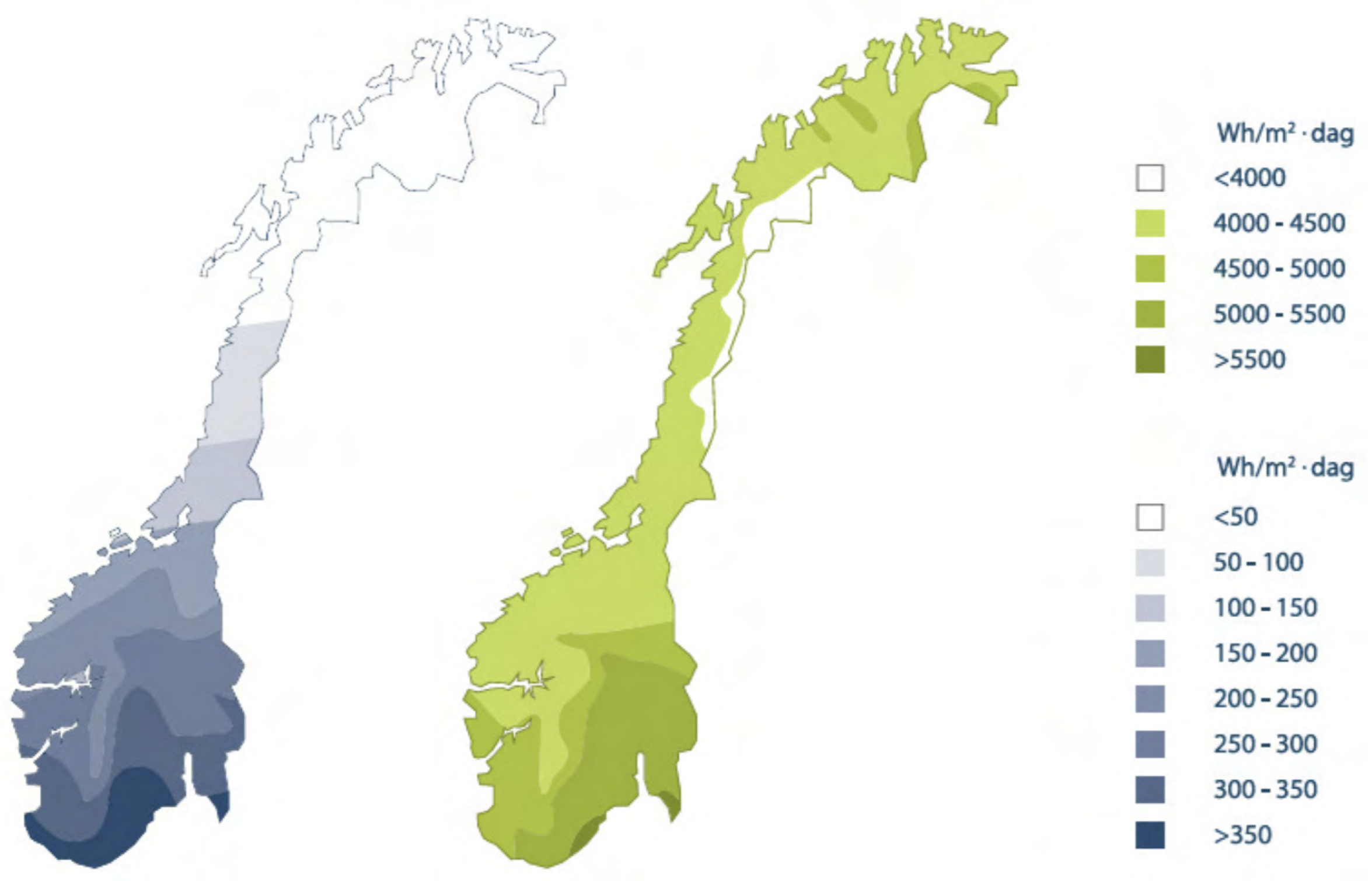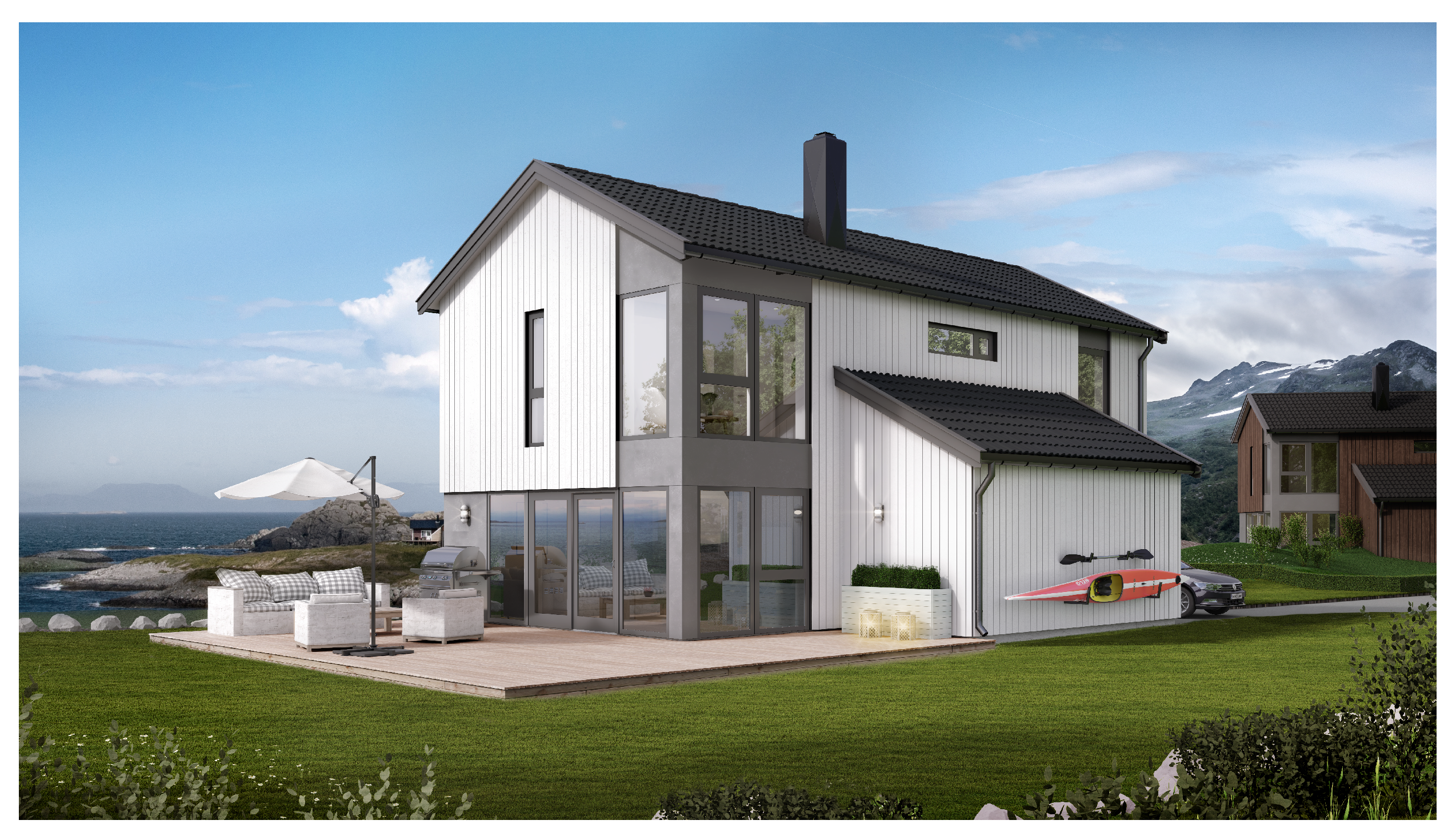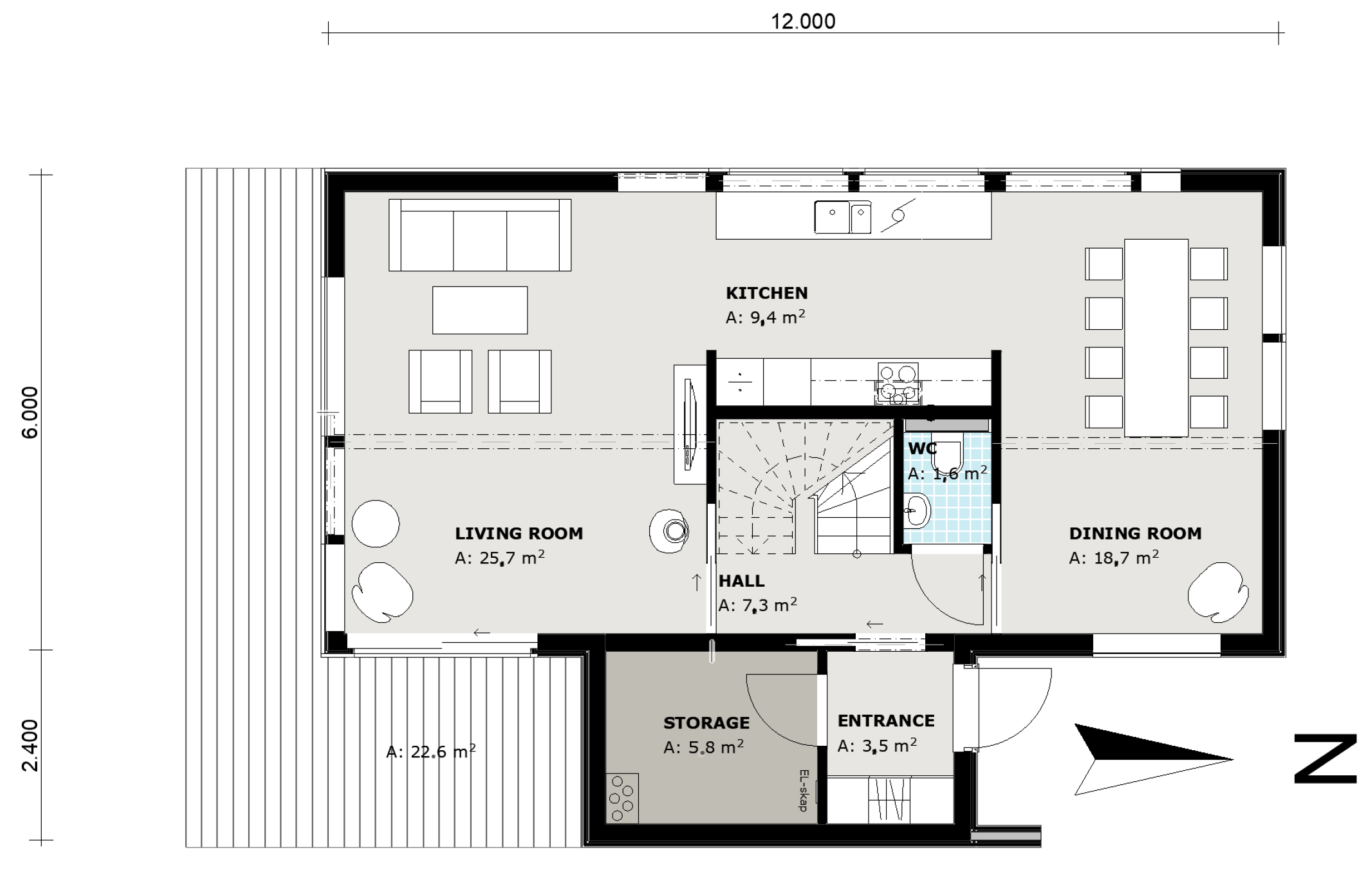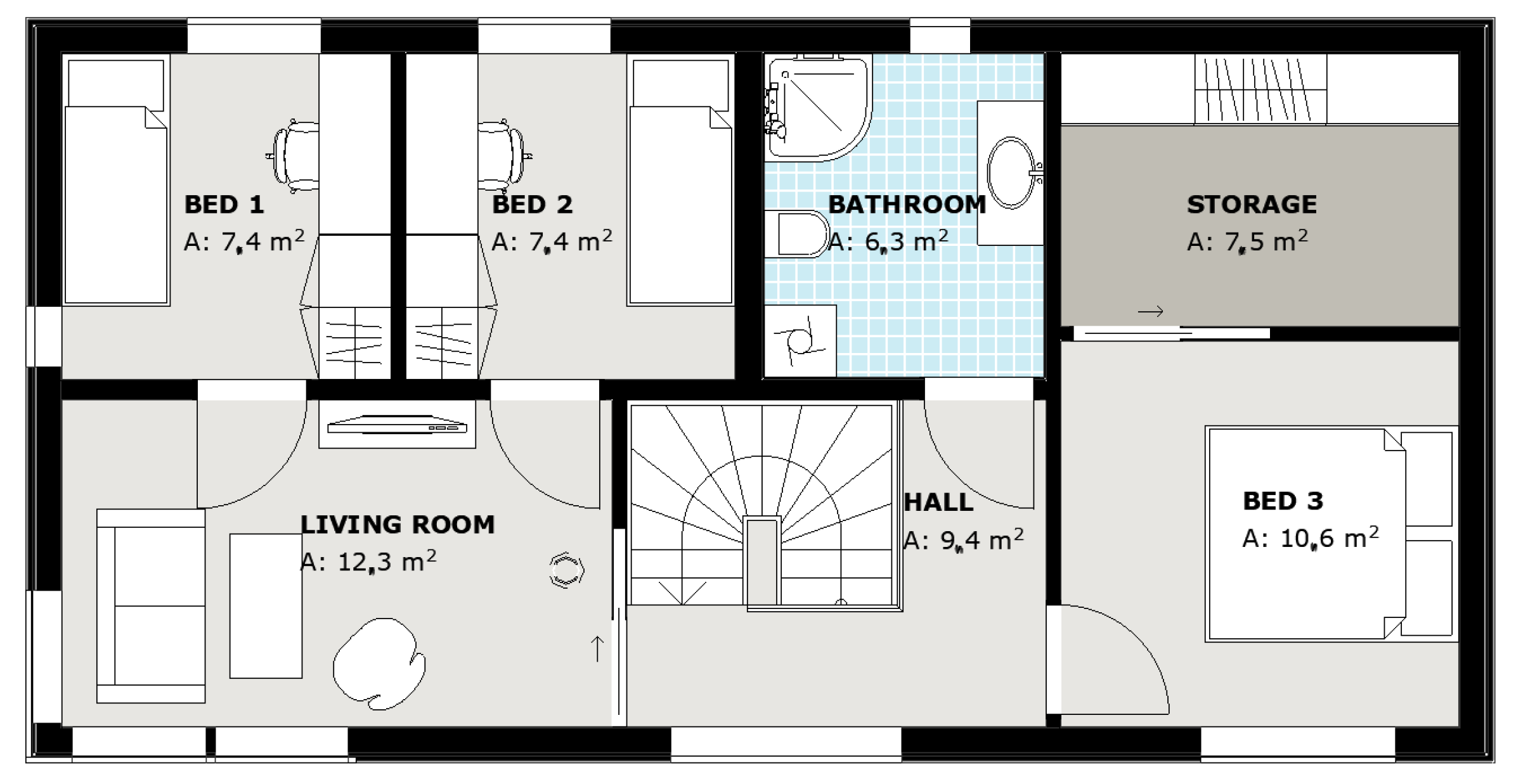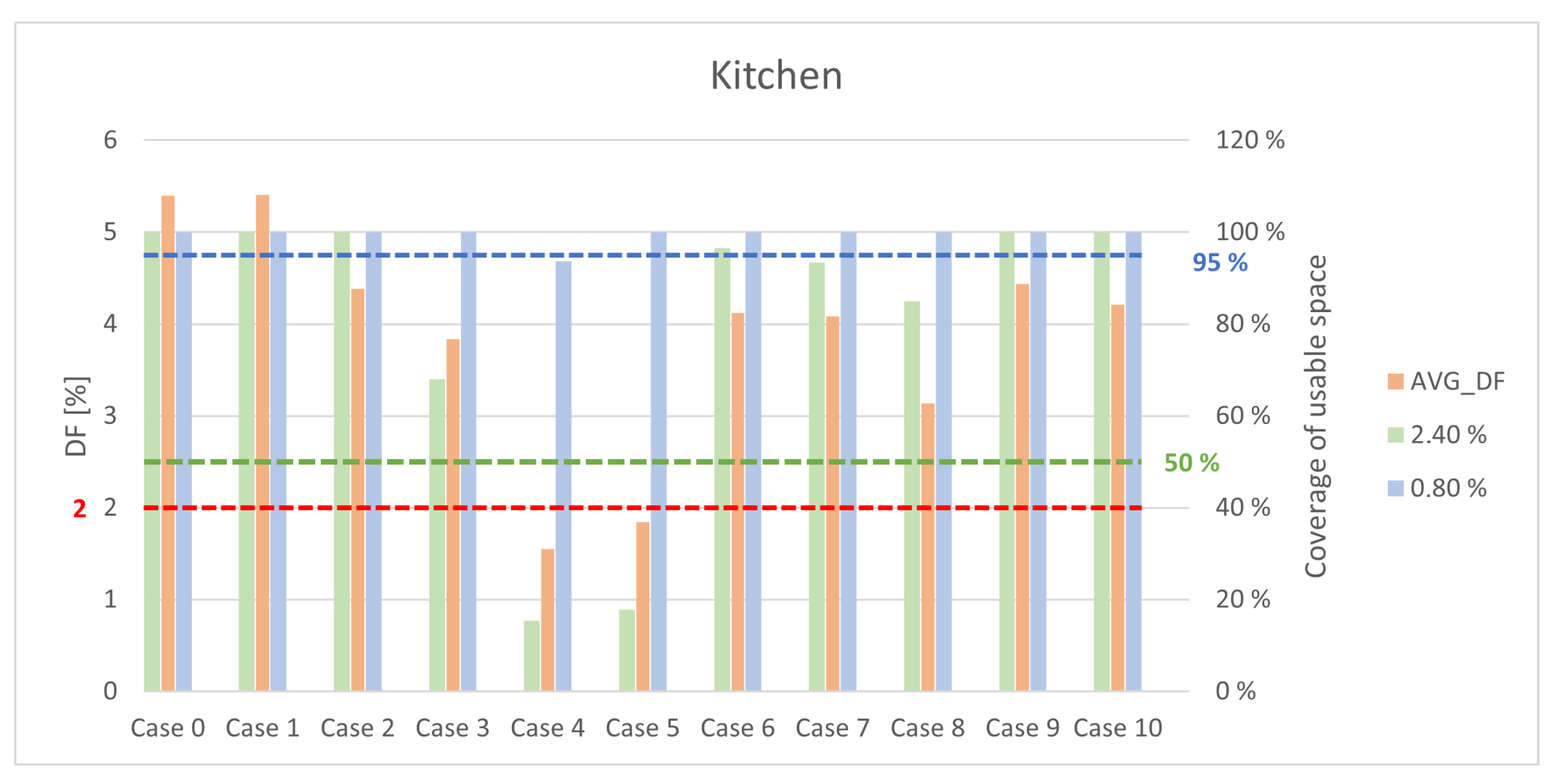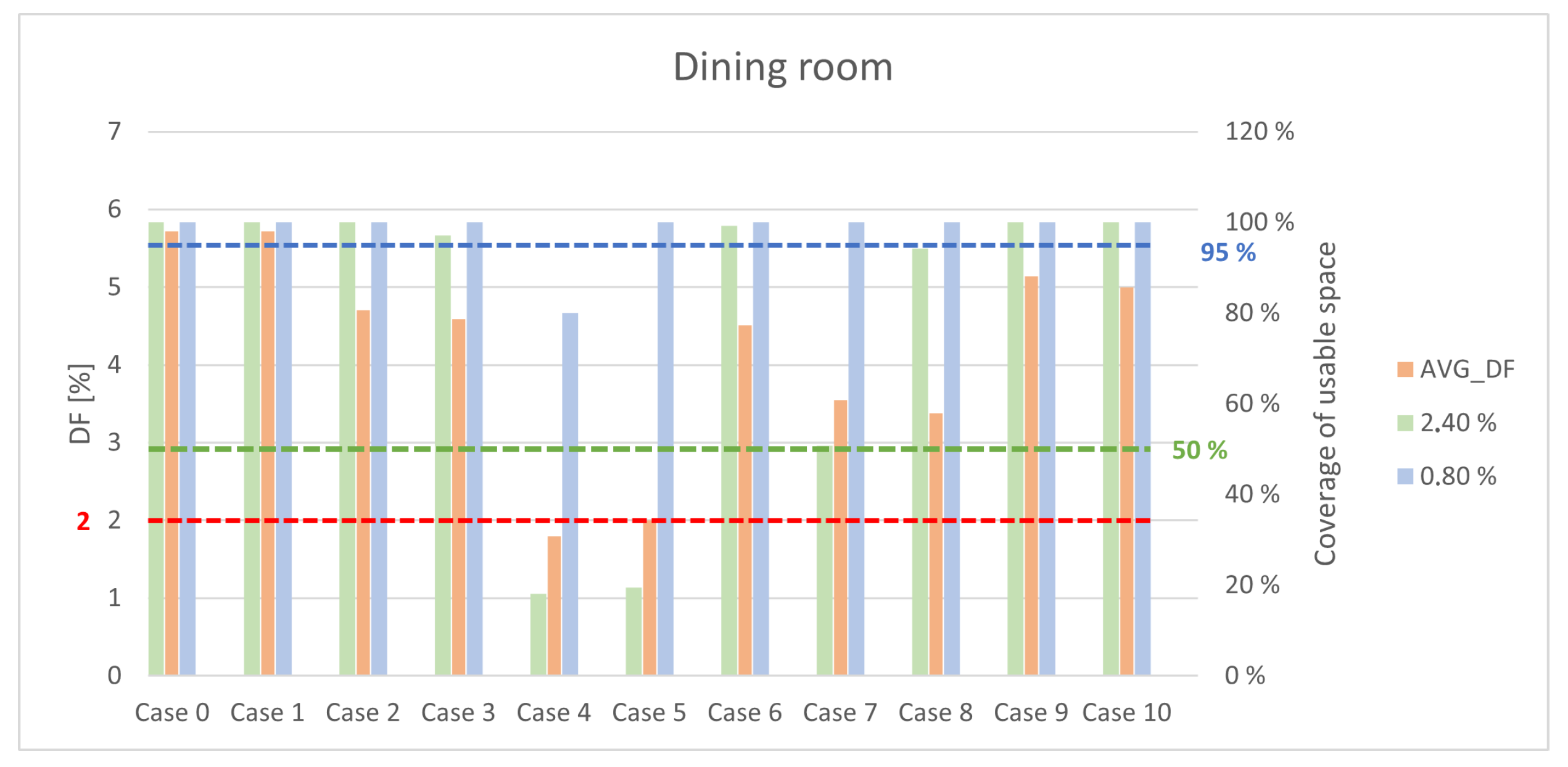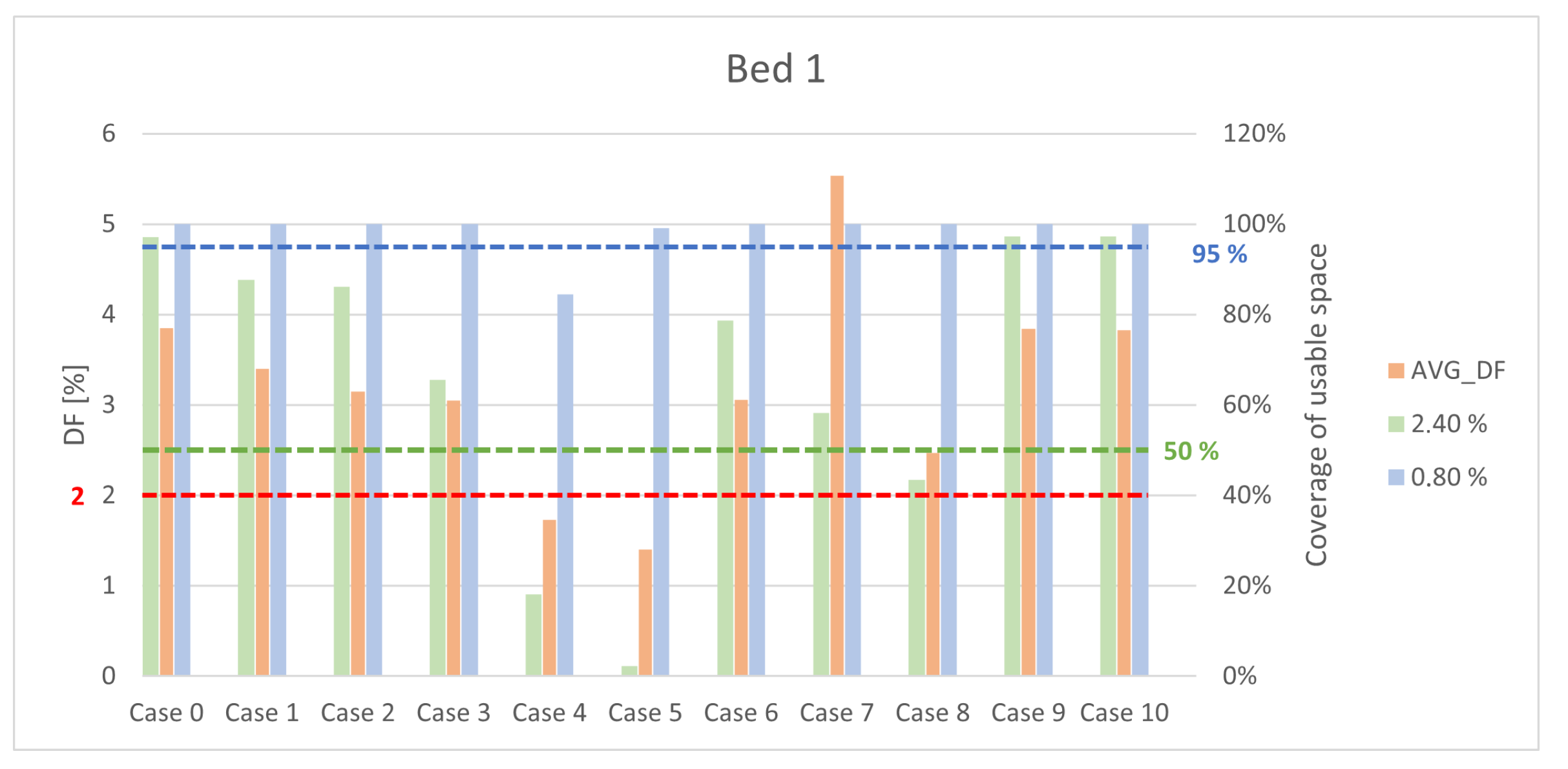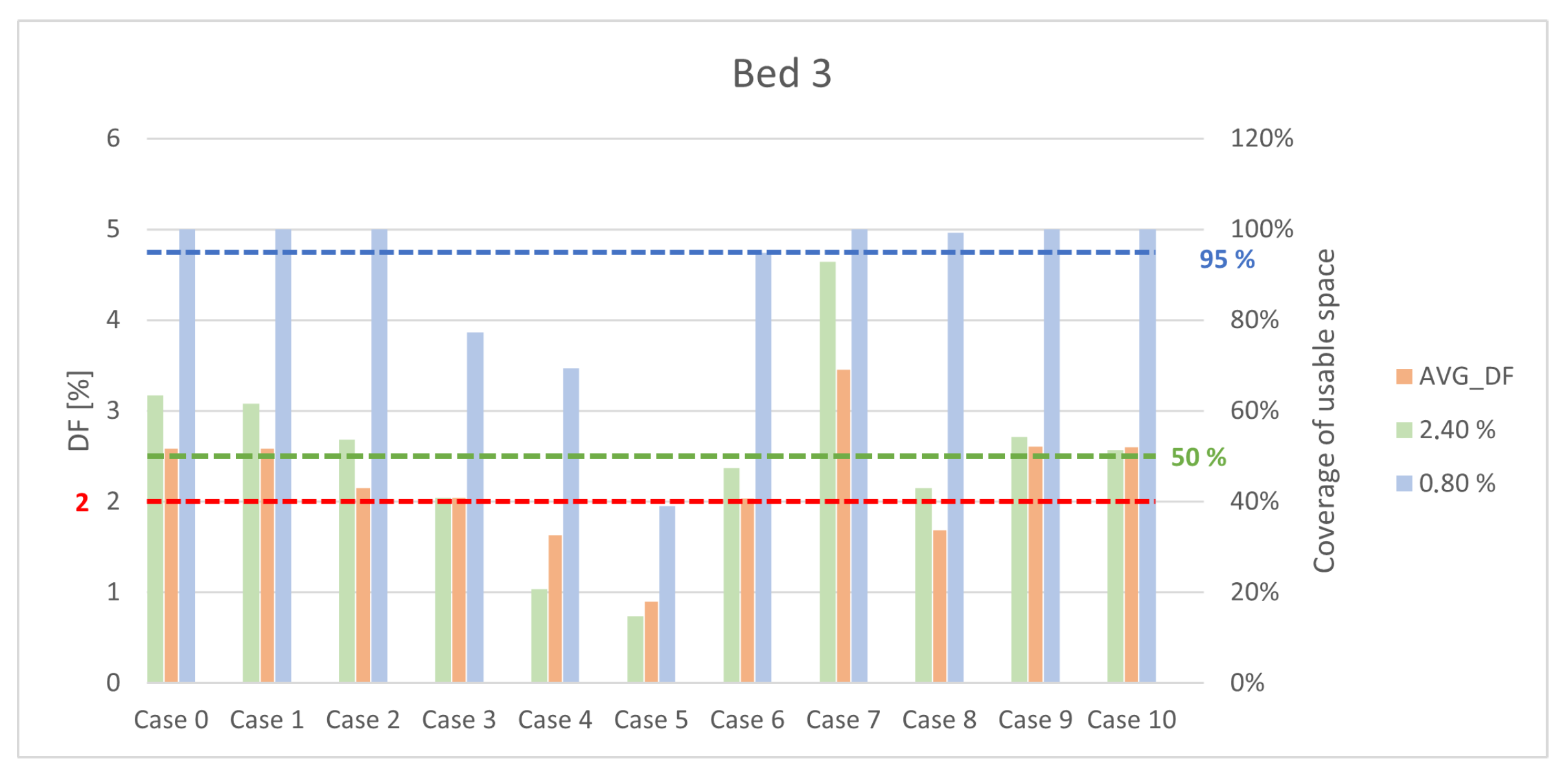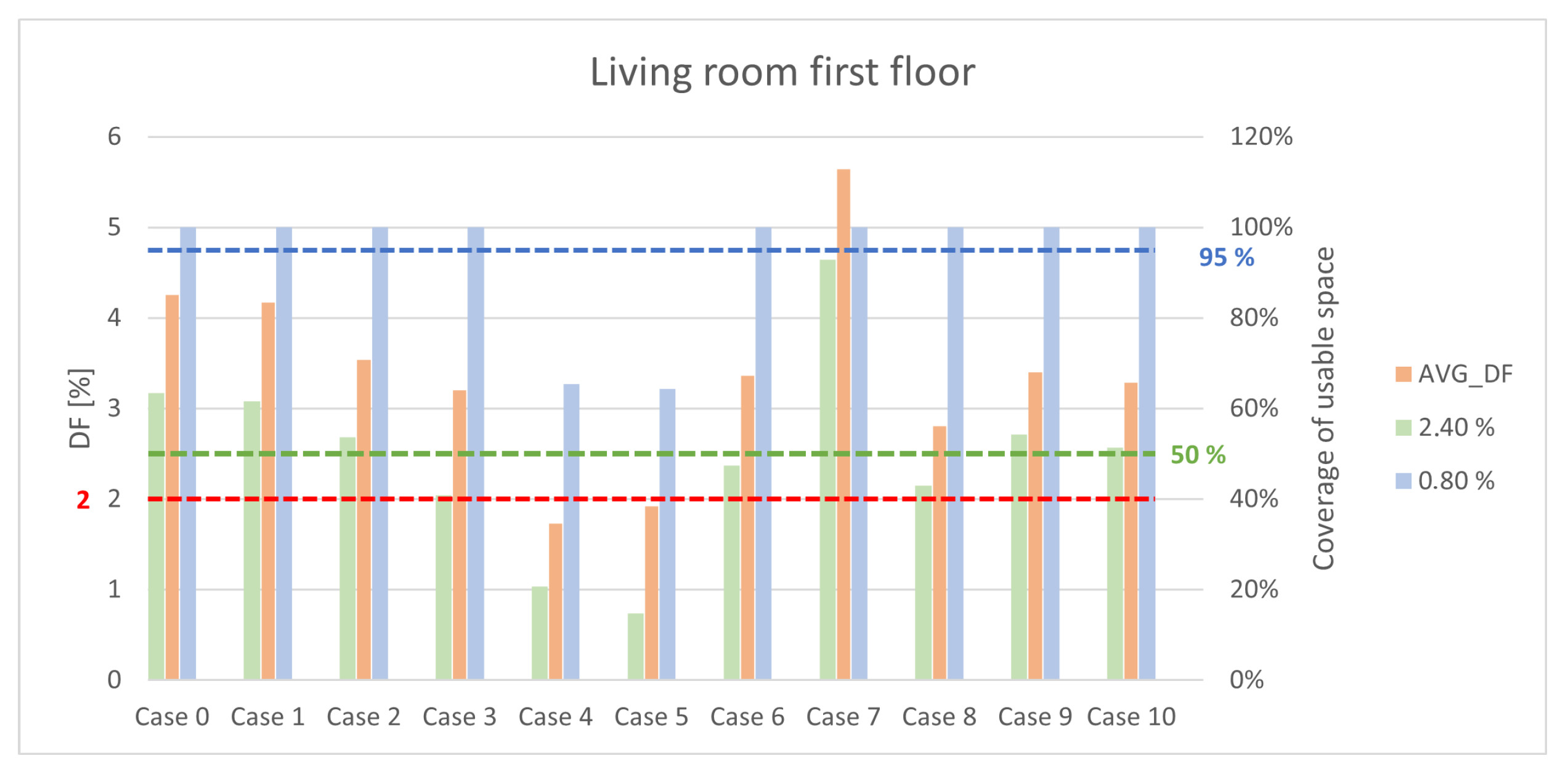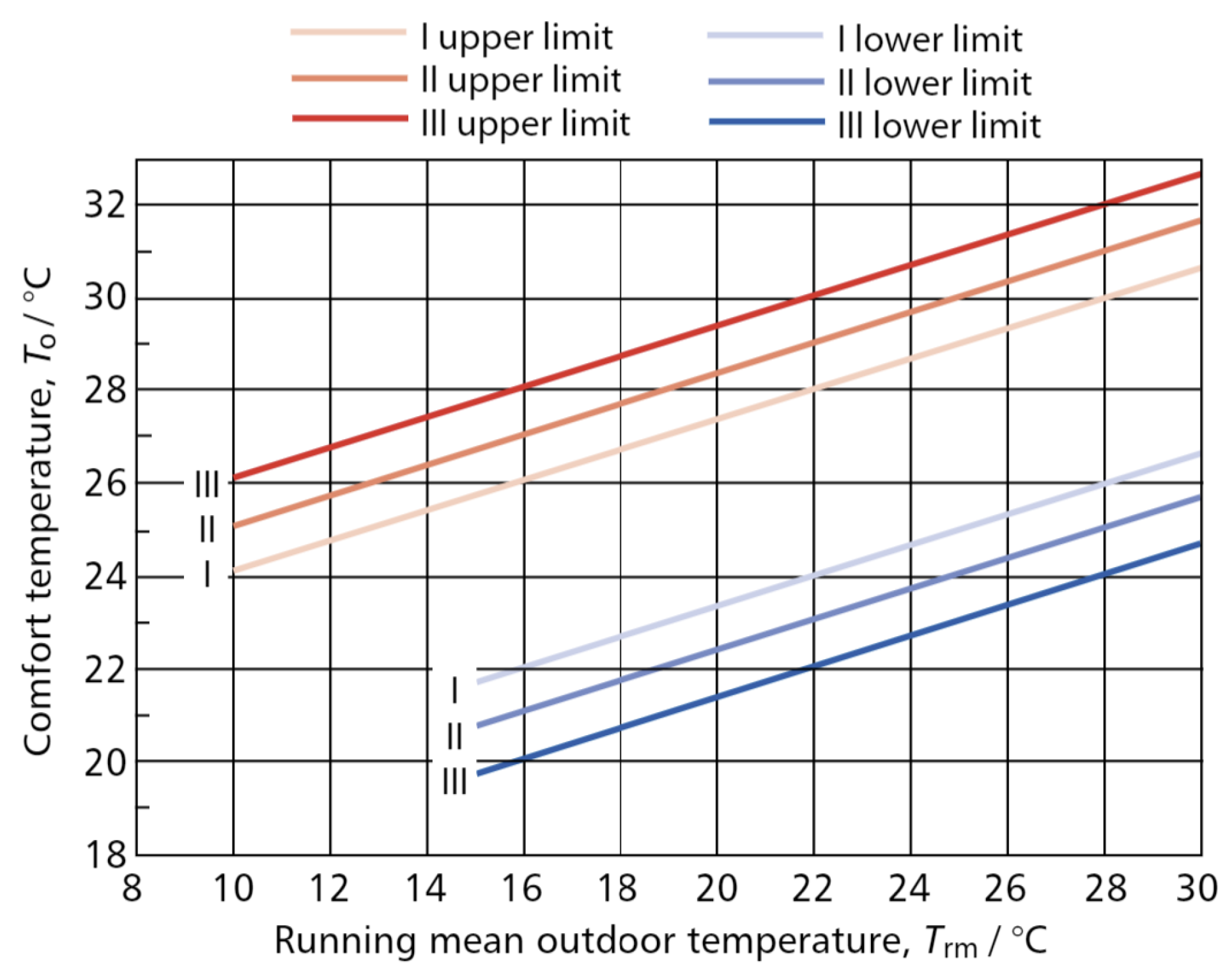1. Introduction
Window design is an important aspect for the overall performance of a building. An unfortunate window design can turn a high-performance building into a building with poor energy performance. How this design is planned affects the energy efficiency in terms of both the annual heating demand and cooling demand, as well as the need for artificial lighting. The amount of solar radiation transmitting through the fenestration also affects the indoor environment. Having sufficient daylight provision influences the visual comfort of the occupants, and has been proved to have benefits on the well-being of the occupants [
1]. Additionally, a good daylight design provides stimulating and well-lit indoor environments. Increased urban density contributes to a more challenging task to provide adequate daylight in living spaces. The surrounding buildings are obstructions to available daylight and may cause poor quality of day-lit spaces. Furthermore, this influences the visual and thermal comfort of the indoor environment. The problem with increased urban density should be considered already in the urban planning and regulations set by local authorities [
2].
The solar radiation that hits the earth is equivalent to 15.000 times the total annual energy consumption for the entire Earth. This solar energy can be utilized either in a passive or active way. Using the solar heat gains through windows for space heating, and the solar radiation as a substitute for artificial lighting are examples of passive strategies [
3]. Principles for active utilization could be solar thermal collectors that directly use of the solar energy to heat water that circulates in the building for space heating and domestic hot water. The conversion of solar energy to electricity by solar panels is also an example of active utilization [
4]. Since Norway is an elongated country with various topography, the solar radiation is very dependent on location and season.
Figure 1 illustrates the variation of solar irradiation in Norway for winter and summer conditions.
Several studies found that daylight has a positive influence on human health and wellbeing. Daylight ensures many qualities both for the indoor environment and psychological wellbeing [
6]. Daylight openings provide connection to the outside while also illuminating indoor surfaces. When human skin is exposed to sunlight, it produces vitamin D, which is linked to several health benefits [
7]. Lansdowne et al. [
8] found that the body also produces serotonin, which helps in improving mood. A recent study discovered that a photoreceptor in the eye is sensitive to the wavelengths in the blue spectrum, which daylight naturally covers, and synchronizes our internal biological clock [
9].
While numerous other European countries specify a minimum number of hours of solar exposure, the Norwegian government has decided to withdraw the paragraph concerning sunlight from the building code in the latest upgrade of the Norwegian technical requirements, TEK17 [
10]. It is, therefore, imperative that the regulations define sufficient minimal criteria for the daylight provision. In a study by Ko et al. and Sepúlveda et al. [
11] it was found that the Estonian daylight standard had limited reliability in predicting daylight, and there was a strong disagreement between the national and European standard. In 2019, the European standard concerning criteria for daylight in buildings (EN 17037) was implemented as a Norwegian standard. The standard encourages building designers to focus on providing sufficient daylight spaces, and also categorizes target ambitions with respect to daylight [
12].
Thermal comfort is an important measurement in building design and affects how the occupants appreciate the indoor environment. On the other side, the occupant’s behavior may have a direct impact on the building’s energy consumption. Another critical aspect of thermal comfort is associated with the risk of overheating. Since thermal comfort is a subjective condition, it is hard to tell at which exact temperature overheating occurs, as it is dependent on the metabolic rate, uncertainties in body mass, fitness and blood flow [
13]. With the anticipated increase in temperature due to climate change, buildings in cold climates face a future with an increased risk for overheating during summer [
14]. Norway experienced a set of extreme heat waves in the summer of 2018 and 2019 [
15]. Li et al. [
16] conducted a study of indoor overheating risk for converted lofts in London. One of their findings was that passive adaptations were not sufficient enough to eliminate overheating, and it is likely that by the 2080s, active cooling will be a necessity. Tian and Hrynyszyn [
17] found in their study that a retrofitting to higher energy standards by improving the airtightness of a building can increase the risk of overheating, even in cold climates. They highlighted that overheating should be paid more attention to based on the expected future climate conditions. Lee et al. [
18] investigated how light shelves with applied photovoltaics could help to maximize building energy efficiency. Light shelves rotated 10 degrees toward the sun proved to be most efficient in terms of PV-production during summer conditions in South Korea.
Norwegian residential buildings are regulated by TEK17. It is, therefore, most relevant to use the given performance criteria for daylight and thermal comfort in this regulation as a scale of measure. The aim of this paper is to investigate how the criteria facilitate a consistent and good performance in terms of daylight and thermal comfort, and the comparison between the Norwegian national regulations and the European standards. The methodology of this study examines a set of parameter changes to an original case building. Each case is simulated in IDA ICE. The results of this study indicate how to optimize the design of the case building in terms of daylight and thermal comfort performance.
4. Results
In the following section, the simulation results are presented. Each case alternative is evaluated in terms of the annual heating demand, daylight and thermal comfort. While energy is displayed collectively on a single table, daylight and thermal comfort are presented in representative tables and figures relevant to the studied rooms in the building.
4.1. Energy
The simulated heating demand is expressed as the total energy need for space heating, including ventilation. An overview of the annual heating demand for each case is presented in
Table 4. As expected, the better insulated walls in Case 2 and reduction in window area in Case 4 decrease the need for annual heating. A decrease of almost 27% for Case 2 is a quite significant performance increase for the building. Just by optimizing the window design, as in Case 7 with the revised window design, there is a profit of 7.5 kWh/m
annually. The light shelves themselves do not influence the energy performance significantly, but there is an advantage in the production of electricity, which can be utilized. The implementation of such an installation is rather based on an expected cost–benefit perspective.
4.2. Daylight
Based on the results for daylight performance, bedroom 2 and bedroom 3 are the worst performing rooms. A possible reason for this may be that these rooms have one-sided light transmittance, and the geometry of these rooms regulates how the light is distributed. Case 4 and Case 5 have obvious issues regarding adequate daylight provision. Furthermore, it is worth noticing that Case 4 is designed with the minimum, defined by the simplified method in TEK17, and it is not approved by any of the used criteria in this paper. A horizontal light shelf obtains a slight decrease in daylight provision, but does not deviate from the reference case concerning criteria acceptance. The rotated light shelf, Case 10, performs similarly but gives more profit with PV-production.
The results for daylight are calculated for each individual room considered. The results are evaluated according to criteria set in TEK17 (
) and NS-EN 17037 (50% of area
and 95% of area
). The following
Figure 8,
Figure 9,
Figure 10,
Figure 11,
Figure 12,
Figure 13 and
Figure 14 display the results for each room with respect to the mentioned criteria.
4.3. Thermal Comfort
By default, the reference model does not satisfy the expected performance regarding overheating hours in TEK17; see
Table 5. The following
Table 5,
Table 6,
Table 7,
Table 8,
Table 9,
Table 10,
Table 11,
Table 12,
Table 13,
Table 14 and
Table 15 present the simulated results for each case, where green represents the satisfied values, red the unapproved values, and yellow the values close to the acceptance level. In contrast to the significant improvement in energy performance for Case 2, thicker walls lead to more severe overheating risk as illustrated in
Table 7. Reduction of the glazing area, Case 4, or improving glazing properties tends to be the most effective measure. Case 6, medium light transmittance, is a more reasonable measure than Case 5, low light transmittance, since the latter has poor performance both for efficient energy use and access to daylight. The revised window design in Case 7 gives a slight overall improvement but still is not satisfactory for bedroom 2 and living room on first floor.
Table 13 for Case 8, static external overhang, shows that static external shading gives good results, and the unapproved rooms fails by a small margin. The light shelves do not influence the thermal comfort performance very much. For most of the cases, there is a correlation between a good energy performance and a bad thermal comfort performance and vice versa.
5. Conclusions
In light of the analysis, optimizing window design is a necessary measure since it contributes to a significant decrease in the energy demand for heating and cooling, providing a balance in terms of optimal conditions for thermal comfort and daylight, in cold climates as well. The results presented for Case 2, with thicker walls, indicate that focusing primarily on well-insulated and more air-tight walls does not exclude the possibility that a significant risk of overheating can occur if a conscious window design is not included, which further confirms the findings by Tian and Hrynyszyn [
17]. This means that technical regulations at the national level should include extended and clearly defined requirements, including thermal comfort and daylight to provide more holistic and sustainable solutions for housing, especially in terms of the expected climate changes.
By performing a revision of window design, the overall performance of the building improves. This indicates that daylight should be considered holistically from the initial stages. By having the window design in mind in the initial stages of planning, it can result not only in better daylight provision, but also in improved energy and thermal comfort performance because they tie together.
Optimized window design, including consideration for daylight, thermal comfort and energy is necessary to achieve an overall, optimal energy performance of a building.
Table 16 presents an overview of the findings from the analyzed cases. The overview shows that each case individually does not fully satisfy all aspects, and there is still a potential for energy savings to achieve a level of zero energy building (ZEB) by optimizing the building envelope parameters. A more optimized version should therefore be reviewed, and this will be a subject of future work.
There should be paid more attention to which criteria are to be used for daylight calculation, as the criteria are not consistent. According to the simulated results presented in this paper, the simplified method in TEK17 gives acceptance of criteria, which neither the average daylight factor nor the criteria in NS-EN 17037 approve. A theoretical combination with Case 3, maximum accepted obstruction, which also is accepted by the simplified method, would give even worse daylight performance. A simplified method should be the most conservative alternative and give the oversized alternative, while the advanced method should be optimized closer to the acceptable limit.
In light of the findings in this study, the criteria for thermal comfort and daylight, if clearly defined, can affect the energy demand for heating and cooling as well as the indoor climate. It is concerning that the regulations are not consistent; revisions should be taken into account at the national level.
